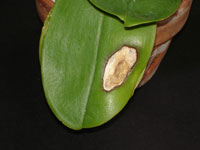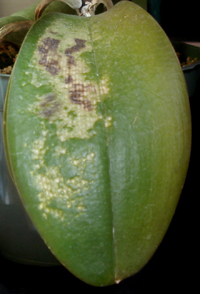 Join Our Newsletter
Join Our Newsletter
Enter your email to receive our free monthly orchid care tips!
Enter Email Here:
Orchid Supplies Corner
In the summer orchids are afforded more light than at any other time of the year. The increased level of sunlight coupled with the high daytime temperatures puts orchids at risk for sunburn. It doesn't take much to burn a leaf, especially when plants are brought outside.
Here are a few things to keep in mind about orchids and sunburned leaves.
 As with any orchid ailment it can be difficult to identify the true cause of leaf damage. The photo
here shows a sunburned spot on a Phalaenopsis after the damage occurred and had time to dry.
A thin white patch with a dark ring is common with sunburn. This patch is dry and the damage
is contained to this area and will not spread any more.
As with any orchid ailment it can be difficult to identify the true cause of leaf damage. The photo
here shows a sunburned spot on a Phalaenopsis after the damage occurred and had time to dry.
A thin white patch with a dark ring is common with sunburn. This patch is dry and the damage
is contained to this area and will not spread any more.
 If the sunburn is contained to a spot such as in the photo above or several dry spots such as the photo on the left there is no need to do anything. The sunburned leaf is still providing sustenance to the plant and so we will choose to leave it alone as long as the damage is dry and contained. The plant will look better once a new leaf grows to cover the damaged one.
If the sunburn is contained to a spot such as in the photo above or several dry spots such as the photo on the left there is no need to do anything. The sunburned leaf is still providing sustenance to the plant and so we will choose to leave it alone as long as the damage is dry and contained. The plant will look better once a new leaf grows to cover the damaged one.
Once leaves have become sunburned the leaf should be watched for signs of rot. Usually the leaves will dry out but in some cases they may begin to turn mushy and rot. Rot on an orchid needs to be stopped quickly as it can spread aggressively.
The following tips can help reduce the incidence of sunburn:
- Acclimate plants slowly to new light conditions. If orchids will be summered outdoors this is especially important as outdoor light conditions, even in partial shade, are significantly brighter than indoors.
- Even high light orchids don't require the type of full sun that tomatoes do. Be careful when summering plants outside. Shade cloth for an orchid greenhouse cuts light levels by about 60%. What looks like light shade outdoors is probably still quite a bit brighter than any spot indoors.
- Light changes with the seasons. The first hot bright days of summer can come as a shock. So can the early fall when leaves fall off the trees but the sun is still bright.
- Bringing orchids outdoors to repot or water is fine but leaving them in the sun while running an errand probably isn't.
- Temperature and air circulation play a role in sunburn along with light levels. Leaves will tend to burn more quickly when the temperature is hot and the air is still.
- Feel the leaves. The leaves should not feel hot. If they do, reduce light or increase air circulation or both.
- Some orchids are a lot tougher than others. Some genera, like Phalaenopsis, will sunburn easily. Others, like Cymbidium, tolerate very high light levels with no problem.
- Opening a window behind orchids may mean they will get too much light. Compensate for the lack of shading from the glass in other ways such as tilting the blinds or moving the orchids in towards the room more.
- Leaves that touch the window or are very close to the window in a very bright location can get sunburned even though the plant is indoors. It's rare but it can happen.
- Be cautious with supplemental lighting. Keep the supplemental lighting at a reasonable distance from the plant. This can be tricky to determine at first. Rather than making dramatic changes quickly, try to make small changes gradually and observe the color of the leaves of the plants between each change. New light bulbs burn much brighter than older ones. Avoid changing all the bulbs in a florescent light fixture at the same time.
Abundant light is a wonderful thing for orchids but too much is not good. We like to grow ours on the bright end of the light range. The above tips are not meant to encourage growing orchids in conditions that are too dark.